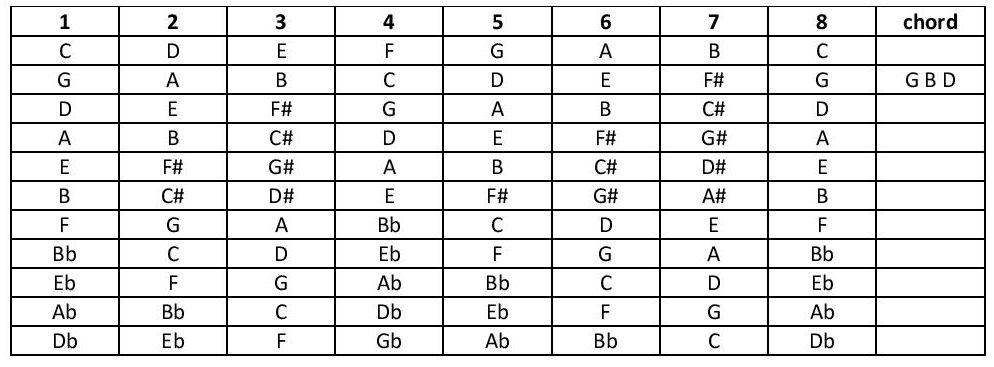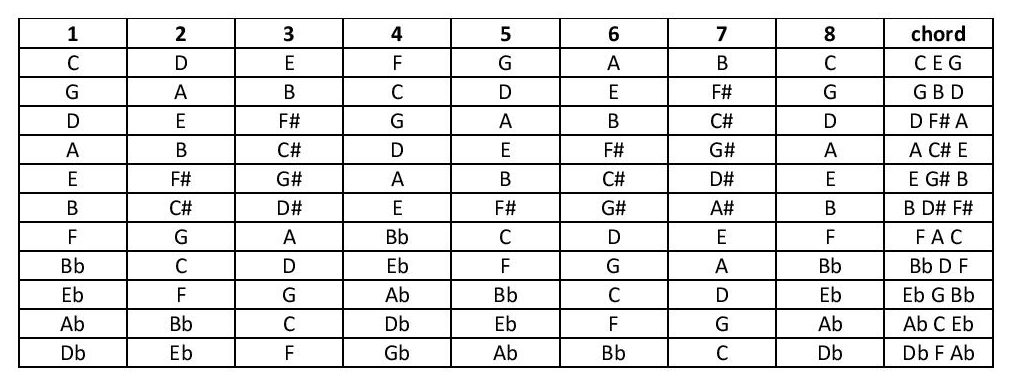Now that you know how to build a scale, we can ask, ‘How do I build a chord?’ First, let’s ask, what is a chord? I’m going to define a chord as being a group of notes (2 or more) played together at one time. With some experimentation, you can prove to yourself that some groups of notes sound really good together and some sound awful. Working with the scale tones can help you easily find the groups of notes that sound really good together.
Although some chords are more complex, for today’s lesson, I will be using 3 note chords only.
Since a lot of bluegrass tunes are played in the key of G, I am going to start my discussion using that scale. At the simplest level, playing ‘in the key of G’ means that the melody of the song is built using the notes of the G scale AND that I will finish the song on a G chord. Which raises the question, what notes are in a G chord?
Remember that the G scale has these specific notes:
G A B C D E F# G
So how do I choose what notes to use in a G chord? First note; you HAVE to use G as your starting point; this is called the ‘root note’.

Without addressing the reasons why, you then skip one scale tone (A) and add the next scale note (B) to the chord you’re building.

Again ignoring reasons for the choice, you again skip one scale tone (C) and add the next (D) to your chord.

And that’s it! You’re done! You have assembled the three notes of a G chord: G B D.
Think about that briefly and you might say, ‘Now wait a minute! Guitars have 6 strings but they play G chords. And pianos have lots of keys and play lots of notes at once. How come there’s only 3 notes in the chord?’ Quite simply, the notes G, B, and D are repeated in different octaves until you run out of strings on guitar or out of fingers on the piano. Even if a whole orchestra plays as many notes as each instrument can manage, if the orchestra plays a simple G chord, every note sounding will be a G, a B, or a D.

To summarize how to build a simple 3 note chord…
- First chord tone: the name of the chord determines what scale to use in selecting chord tones. The root note of the chord will be the 1st note of the scale of that name. If building a G chord, first note of the scale is G so the first tone of the G chord is also G.
- Next chord tone: look again at the scale of the chord name you’re building. You used the 1st scale tone as the root note of your chord. To choose the next note of the chord, skip one scale tone and add the next one to your chord. In the case of a G scale, you’ll skip the A (2rd tone of the scale) and add B (3rd tone) to the chord.
- Final chord tone: again, look at the scale of the chord name you’re building. So far your chord is built of the 1st scale tone (G) combined with the 3rd scale tone (B). To choose the final note of our 3 note G chord, skip the 4th tone (C) and add the 5th tone (D) to the chord. Your G chord will be comprised of G’s, B’s, and D’s.
OK, now it’s your turn. Here are the 11 scales we have discussed so far in this Seat-of-the-Pants Music Theory course. Figure out the chord tones for each scale. We already did G so I have completed that one. Don’t peek but the answers are at the bottom of the page.

Answer table of chord tones in root chord for selected scales
